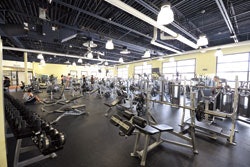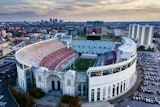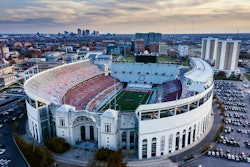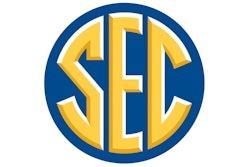The origins of the industry's environmental consciousness remain underfoot in strength and a host of other applications.
 HEAVY DUTY The utilitarian tradition of recycled rubber flooring is well-established.
HEAVY DUTY The utilitarian tradition of recycled rubber flooring is well-established.It's a matter of simple intuition that using recycled materials benefits the environment, which is why the recycled rubber flooring industry has found a foothold in the movement to make fitness facilities more sustainable. Whatever the specifics of each manufacturer's products, the category of weight room flooring is, collectively, a useful resilient flooring material that would otherwise constitute rubber waste products heaped in a landfill.
The process that effects this transformation begins with discarded postconsumer or preconsumer rubber products. The primary source of material in the recycled rubber flooring industry is a postconsumer product - old tires recovered from landfills. The tires are ground up, cleaned, separated from metal impurities using magnets and sold to flooring manufacturers.
Preconsumer recycled rubber is rubber discarded as a byproduct of manufacturing processes - scraps and trimmings that accumulate on the factory floor. Since preconsumer rubber waste is less likely to end up in a landfill than postconsumer products, it is clearly advantageous, in terms of waste-stream reduction, for a flooring product to be composed of postconsumer materials, as is made clear by the U.S. Green Building Council's LEED guidelines. To be LEED-eligible, the cost of materials with recycled content must represent at least 10 percent (one LEED point) or 20 percent (two LEED points) of the total value of the materials used. However, while 100 percent of postconsumer materials can be so counted, only 50 percent of preconsumer materials can.
Once the rubber mix has been determined, the flooring manufacturer uses polyurethane to bind the material. It is this part of the process that raises the ire of the most environmentally conscious among us (see "Rubber Soul"), as polyurethanes can be mixed with solvents in order to make them less expensive. The resulting volatile organic compounds (VOCs) released in vapor form can collect in the atmosphere and compromise indoor air quality. According to industry insiders, however, leading recycled rubber flooring companies receive their polyurethanes from suppliers whose products are free of solvents.
The mixture of recycled rubber and polyurethane is compressed and formed into either of two products that constitute the majority of the recycled rubber flooring market - a rolled good that is typically a half-inch thick or less, or molded rubber tiles (square or interlocking) that are typically one inch thick or more. Rolled rubber flooring is fabricated into a sheet at a desired density and thickness, with the option of adding EPDM (Ethylene Propylene Diene Monomer) flecks to the mix of recycled rubber and polyurethane to provide flooring in a variety of colors. In the case of the thicker molded rubber tiles, the bottom portion of the tile, which makes up the majority of the flooring product's recycled content and profile, is topped with a thinner top layer of synthetic rubber. EPDM rubber is the elastomer most commonly used to create the surface layer, but some companies use TPV (ThermoPlastic Vulcanisate). This top layer is also bound in polyurethane. Because it is synthetic, this layer can be produced in a variety of colors.
LEED guidelines go beyond recycled content in ensuring environmentally sensitive construction and installation waste management. One point can be awarded to a facility if at least 50 percent of nonhazardous construction and demolition debris is salvaged during installation or recycled afterward, and certain rubber flooring companies offer services for easy return of excess scrap. (The USGBC awards an additional LEED point if 75 percent of debris is salvaged or recycled.) Another way to earn LEED points is by using products that have undergone the entire manufacturing process in close proximity to the destination facility. One point is awarded if 10 percent (and two points if 20 percent) of the material value of the product was produced within a 500-mile radius. One LEED point can be awarded to a facility if the sealants and adhesives used in manufacturing and installation have a VOC content that meets the standards of the South Coast Air Quality Management District, made up of Los Angeles, Orange, Riverside and San Bernardino counties in Southern California. The final way to earn LEED points is by using low-VOC materials approved under the Resilient Floor Covering Institute's FloorScore® certification.
Square tiles are more commonly installed using adhesives than are rolls or interlocking tiles, but each company will specify whether or not its products require an adhesive. Manufacturers that make flooring requiring adhesives promote this airtight installation method as better for protecting against bacteria and mold growth beneath and in between flooring sections. Companies that do not require adhesives highlight the advantage of an easier installation process and reversibility.
Most companies offer a wide variety of color options, including custom graphics, and different textures, as well. Neither of these characteristics - nor, indeed, surface performance - are affected by a floor's recycled content.
Its ability to accumulate LEED credits has only enriched the utilitarian résumé of recycled rubber flooring, which has long been a standard-bearer of sustainability in the athletic, recreation and fitness industry. Tough and resilient, the traditionally black flooring comes with a well-established tradition of green.




































